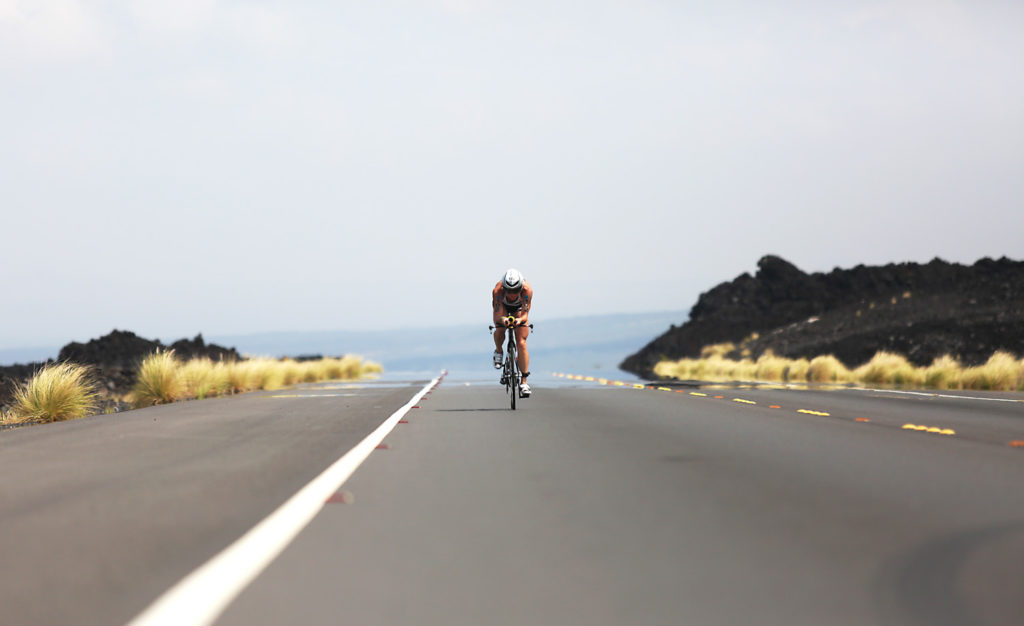
Professional Triathlete Jesse Vondracek shares his training and racing tips on how to acclimate to the heat and when to take it indoors.
Given that my Facebook feed consists of posts lamenting 107 degree temps, it’s safe to say that summer is in full swing in Tucson and most of the United States. Heat is simply a form of stress on the body. If you are training in the heat, your body needs to spend energy to counteract that. Your blood must flow to your skin as well as your muscles. Your sweat helps cool you down, which works well in the short term. As time goes on, this leads to “fun” things like dehydration resulting in a huge decrease in performance. Even prior to becoming dehydrated, your perceived effort and heart rate go up compared to similar paces and power numbers on a cooler day. This is because your body is busy dealing with heat stress and your blood must be used for cooling. In a VO2 max test on elite athletes, athletes had approximately a 2% decrease in performance (Zhao). The important take away here is this is in a test lasting less than 15 minutes and even before dehydration has a chance to slow you down.
Stress is Stress
Before dehydration, we have heat stress. I am sure you’ve heard or read before stress is stress. In other words, your brain interprets all stressors similarly. Whether you had a hard day at work, are stuck in traffic, or are trying to do intervals in 110 degree heat, the same chemicals are released in your brain to deal with stress. The difference in these stresses is that the effect of heat increases over time. Since your boss is not riding with you that stress will likely lessen, while heat stress increases over time.
Creeping Dehydration
After life, heat, and physical stress from training, you’re now dealing with dehydration. If you are 2% dehydrated (e.g a loss of 3lbs in a 150 pound male) you will have a 5% decrease in performance in an event as short as a 5k (Jeukendrup). I challenge you to go for a run in the heat and see how much water weight you lose. This 2% dehydration causes decreased sweat rate, reduced skin blood flow, reduced blood volume, increased core temperature and rate of muscle glycogen use. All of these factors contribute to a higher perceived effort. Even just the increase in glycogen use forces you to slow down in order to conserve glycogen.
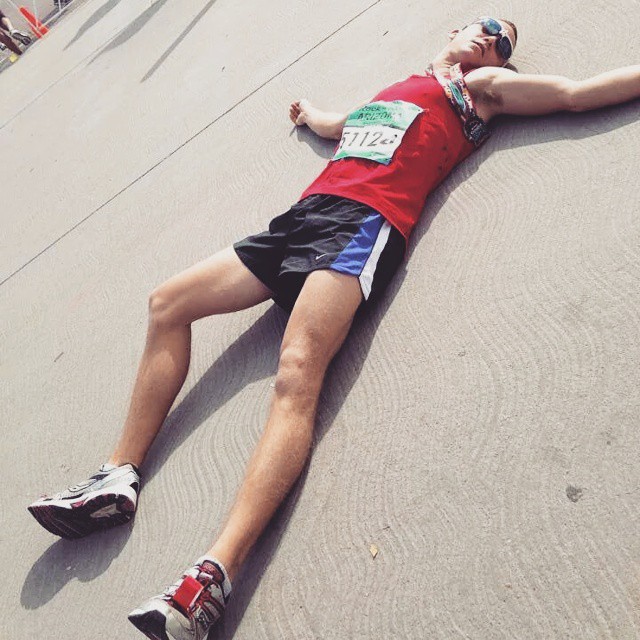
Perceived Effort
If you have to deal with multiple stressors at once or even just prolonged time in the heat, it’s important to remember that your pace or speed will be effected. It is in moments like this that perceived effort is so important to monitor. If you feel like you are putting out 300 watts, but only hitting 260, your actual effort is closer to that on a cool, less stressful day. Unless you are suffering from deep fatigue, you should still complete the workout, but understand that your times will be slower. Training in hot conditions taxes your body’s systems and takes a toll on overall performance, the training benefit is not exactly the same, but very similar.
Indoors vs. Outdoors
If you want the same benefit, or it is 110 out, you can train inside. This reduces the chance of heat-related injury and means you can nail the workout as it was written. There is a benefit to both training in less than ideal conditions and moving things indoors at times. For easy days and short workouts, I say get outside. Help train your body to deal with the heat. If you are preparing for a hot race this is crucial. There are many ways to acclimate to the heat. A good way to start about three weeks prior to your race is perform 3-5 low intensity workouts a week in the heat. You want to aim to be slightly dehydrated to train it to deal with similar race day conditions. As you adapt, your body will increase the relative temperate at which you begin to sweat, and lower your heart rate in the heat. You do not want to sacrifice your hard training sessions by making them all in the heat and losing quality. The heat sessions should be aerobic only, and I recommend moving key workouts indoors or doing them early in the morning to avoid the heat. Another way to aid heat adaptation is to jump in a sauna a few times a week for 20-30 minutes post workout. This has a similar effect to performing easy sessions in the heat.
Recovery After Heat Training
Keep in mind that heat training will increase recovery time and fatigue from a workout. You need to make sure you properly rehydrate and replenish electrolytes after these sessions. As you add heat sessions into your training, do so slowly. See how your body reacts first, then go from there. Keep in mind that the point is to be acclimated on race day, and be able to race faster. Keeping the goal in mind will help you balance quality sessions, heat acclimation, and recovery.
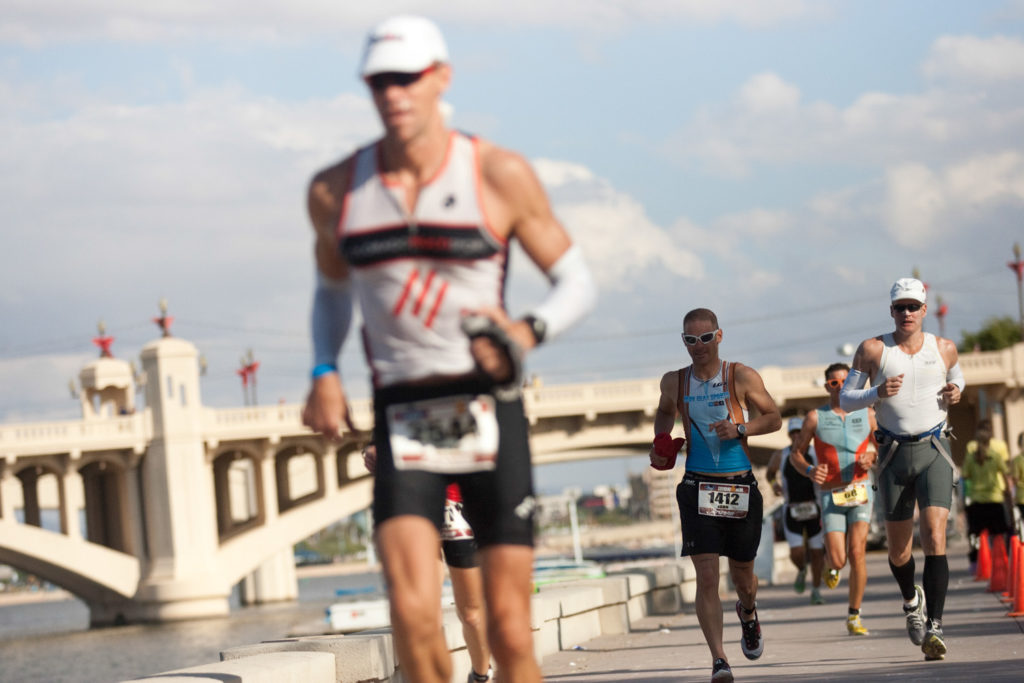
Racing in the Heat
If you are lucky enough to have a race day with high heat and humidity you need to be mentally ready for the challenging conditions. The number one way to do this is to plan your hydration strategy. I have heard a great deal of talk about relying on thirst to consumer liquids rather than drinking according to a plan. If you are going for a walk, I totally agree with this idea. If you are in the middle of a triathlon and have minimal energy to spend processing water/nutrition at any one time, I totally disagree.
Make Drinking a Priority
Prioritizing drinking might mean you slow down more at aid stations, or even stop to ensure you get a bottle. Your ride time might lose a minute or two, but as you run past people walking on the run course, you will thank yourself for the foresight. I set a timer on my watch to remind myself to eat and drink at various intervals throughout the ride. When I am riding hard, I need to focus on riding hard. If my mind drifts to water, heat, the scenery, I slow down. I need to keep as much as I can on autopilot. If it is hot, I make sure I am drinking about two bottles of water an hour and 300-400 liquid calories (water and gel mix). Your body cannot digest calories without water, so water is a must. The closer you can stay to hydrated at the end of the bike, the better off you will be starting the run.
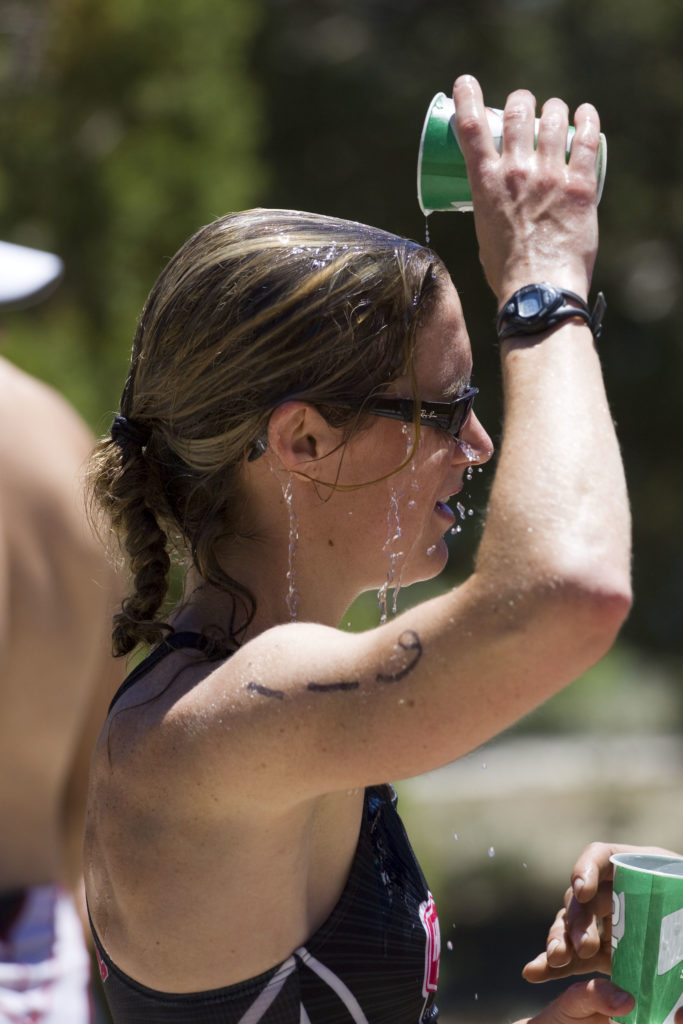
Heat-Specific Pacing Strategy
In addition to a hydration strategy, it’s also good to have a heat-specific pacing strategy. On both the bike and run your watts/pace might be a little slower to accommodate for the heat. You might be able to get away with your usual power on the bike if you are hydrating well, but the run will most likely be slower. Knowing your perceived effort levels will help you run as fast as you can without exploding. On the run, work the aid stations. They are all set up the same, and begin and end with water. Hit both. Drink water at every aid station. If you start peeing a ton, it’s okay to back off some. I also love throwing ice in my kit, which gives my body a few cold spots to focus my energy on. In addition to pacing and hydration, make sure you have a nutrition plan and try your best to stick to it on the run. I take a gel approximately every 30 minutes on the run, and supplement with gatorade and cola between cups of water.
Salt Up
The last thing to consider when preparing for a hot race is electrolytes or salts. I never thought these were an issue for me until I was running down the course at Ironman Arizona looking for chicken broth when it was 100 degrees and sunny. I then realized why I might be craving a hot beverage. If you are drinking bottles and bottles of water and sweating out more than just water, you need to help replace your electrolytes. This is a touchy subject because everyone sweats different ratios of electrolytes. It’s a good idea to try a few things well before race day, and find a plan that works for you. If things get funky on race day, don’t be afraid to deviate (and drink more cola), but start out with a calculated plan. I tend to add some electrolytes to my water and gel mix bottle and have a little salt ready in case I need it on the run. Most gels have a fair amount of sodium in them. Some do not, so know what you have, and know what is on the course in order to make good choices.
Have fun, stay cool, and stay hydrated!
Bibliography:
Zhao, Jiexiu Effects of heat and different humidity levels on aerobic and aerobic exercise performance in athletes. May 24, 2013. http://www.sciencedirect.com/science/article/pii/S1728869X13000087
Jeukendrup, Asker. Dehydration and its effects on performance. 2010. http://www.humankinetics.com/excerpts/excerpts/dehydration-and-its-effects-on-performance
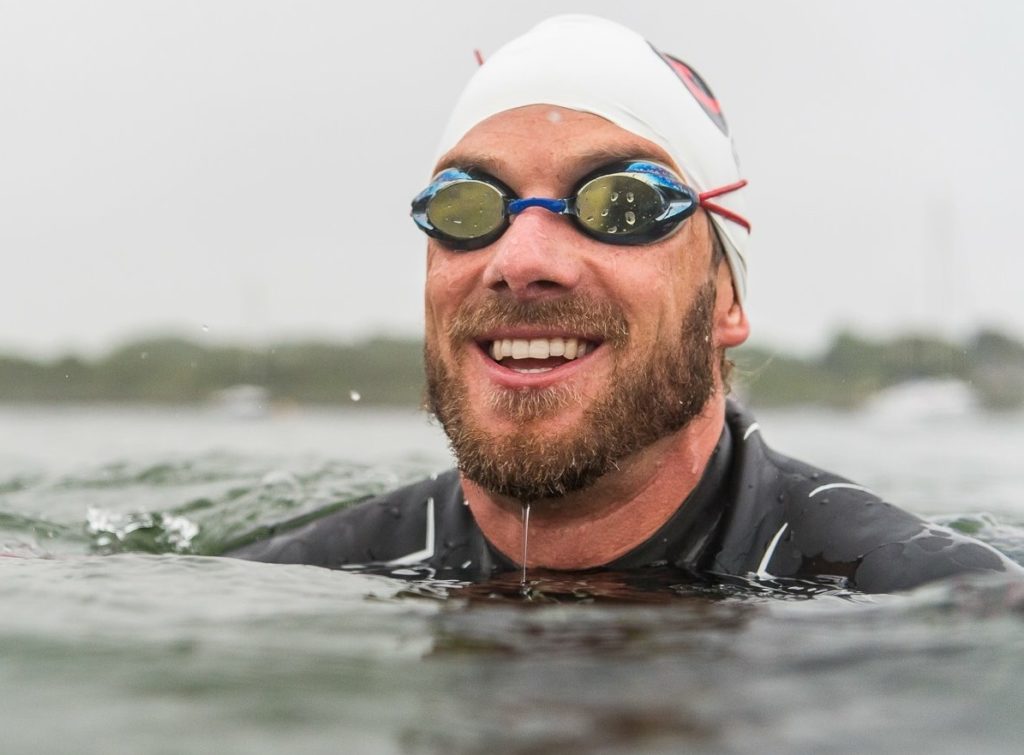 About the Author: Jesse Vondracek is a Professional Triathlete with an IRONMAN PR of 8:27. He has raced in hundreds of triathlons, 19 IRONMANs, and has 0 DNFs. Jesse is the Head Coach at Top Step Training. He lives and trains with his wife Amy Cole and their two mutts. He can be reached at www.topsteptraining.com or Jesse Vondracek on Facebook.
About the Author: Jesse Vondracek is a Professional Triathlete with an IRONMAN PR of 8:27. He has raced in hundreds of triathlons, 19 IRONMANs, and has 0 DNFs. Jesse is the Head Coach at Top Step Training. He lives and trains with his wife Amy Cole and their two mutts. He can be reached at www.topsteptraining.com or Jesse Vondracek on Facebook.
